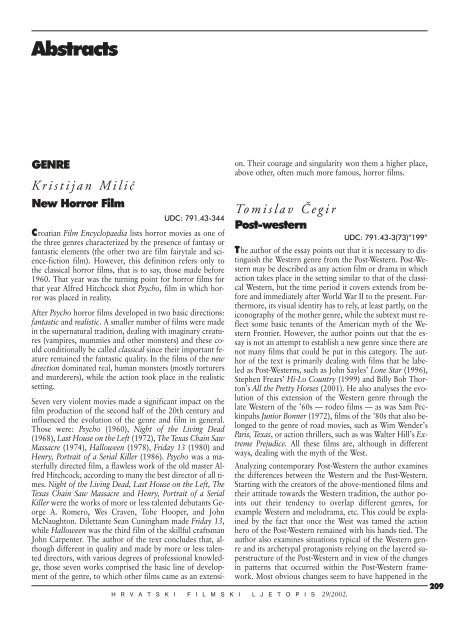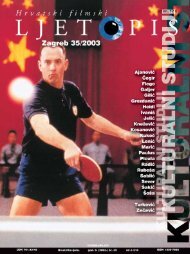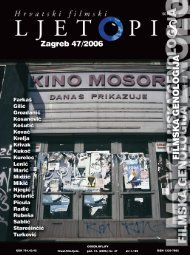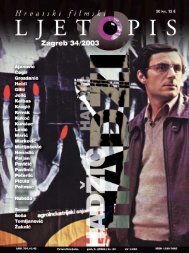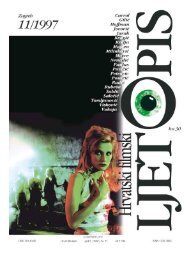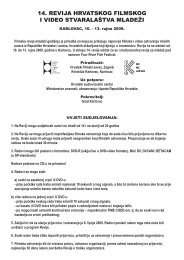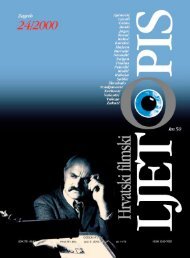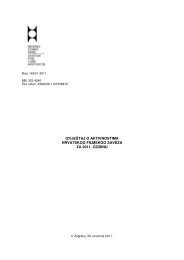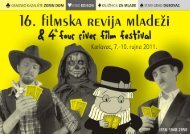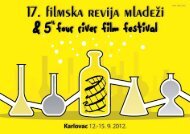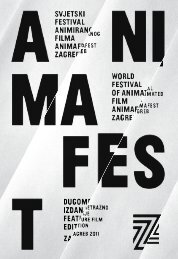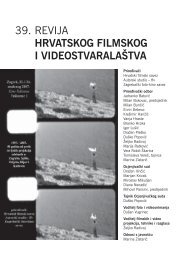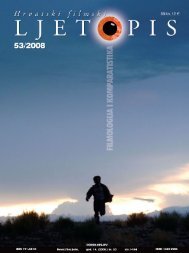Create successful ePaper yourself
Turn your PDF publications into a flip-book with our unique Google optimized e-Paper software.
Abstracts<br />
GENRE<br />
Kristijan Mili}<br />
New Horror Film<br />
UDC: 791.43-344<br />
Croatian Film Encyclopaedia lists horror movies as one of<br />
the three genres characterized by the presence of fantasy or<br />
fantastic elements (the other two are film fairytale and science-fiction<br />
film). However, this definition refers only to<br />
the classical horror films, that is to say, those made before<br />
1960. That year was the turning point for horror films for<br />
that year Alfred Hitchcock shot Psycho, film in which horror<br />
was placed in reality.<br />
After Psycho horror films developed in two basic directions:<br />
fantastic and realistic. A smaller number of films were made<br />
in the supernatural tradition, dealing with imaginary creatures<br />
(vampires, mummies and other monsters) and these could<br />
conditionally be called classical since their important feature<br />
remained the fantastic quality. In the films of the new<br />
direction dominated real, human monsters (mostly torturers<br />
and murderers), while the action took place in the realistic<br />
setting.<br />
Seven very violent movies made a significant impact on the<br />
film production of the second half of the 20th century and<br />
influenced the evolution of the genre and film in general.<br />
Those were: Psycho (1960), Night of the Living Dead<br />
(1968), Last House on the Left (1972), The Texas Chain Saw<br />
Massacre (1974), Halloween (1978), Friday 13 (1980) and<br />
Henry, Portrait of a Serial Killer (1986). Psycho was a masterfully<br />
directed film, a flawless work of the old master Alfred<br />
Hitchcock, according to many the best director of all times.<br />
Night of the Living Dead, Last House on the Left, The<br />
Texas Chain Saw Massacre and Henry, Portrait of a Serial<br />
Killer were the works of more or less talented debutants George<br />
A. Romero, Wes Craven, Tobe Hooper, and John<br />
McNaughton. Dilettante Sean Cuningham made Friday 13,<br />
while Halloween was the third film of the skillful craftsman<br />
John Carpenter. The author of the text concludes that, although<br />
different in quality and made by more or less talented<br />
directors, with various degrees of professional knowledge,<br />
those seven works comprised the basic line of development<br />
of the genre, to which other films came as an extensi-<br />
on. Their courage and singularity won them a higher place,<br />
above other, often much more famous, horror films.<br />
Tomislav ^egir<br />
Post-western<br />
UDC: 791.43-3(73)”199”<br />
The author of the essay points out that it is necessary to distinguish<br />
the Western genre from the Post-Western. Post-Western<br />
may be described as any action film or drama in which<br />
action takes place in the setting similar to that of the classical<br />
Western, but the time period it covers extends from before<br />
and immediately after World War II to the present. Furthermore,<br />
its visual identity has to rely, at least partly, on the<br />
iconography of the mother genre, while the subtext must reflect<br />
some basic tenants of the American myth of the Western<br />
Frontier. However, the author points out that the essay<br />
is not an attempt to establish a new genre since there are<br />
not many films that could be put in this category. The author<br />
of the text is primarily dealing with films that he labeled<br />
as Post-Westerns, such as John Sayles’ Lone Star (1996),<br />
Stephen Frears’ Hi-Lo Country (1999) and Billy Bob Thorton’s<br />
All the Pretty Horses (2001). He also analyses the evolution<br />
of this extension of the Western genre through the<br />
late Western of the ’60s — rodeo films — as was Sam Peckinpahs<br />
Junior Bonner (1972), films of the ’80s that also belonged<br />
to the genre of road movies, such as Wim Wender’s<br />
Paris, Texas, or action thrillers, such as was Walter Hill’s Extreme<br />
Prejudice. All these films are, although in different<br />
ways, dealing with the myth of the West.<br />
Analyzing contemporary Post-Western the author examines<br />
the differences between the Western and the Post-Western.<br />
Starting with the creators of the above-mentioned films and<br />
their attitude towards the Western tradition, the author points<br />
out their tendency to overlap different genres, for<br />
example Western and melodrama, etc. This could be explained<br />
by the fact that once the West was tamed the action<br />
hero of the Post-Western remained with his hands tied. The<br />
author also examines situations typical of the Western genre<br />
and its archetypal protagonists relying on the layered superstructure<br />
of the Post-Western and in view of the changes<br />
in patterns that occurred within the Post-Western framework.<br />
Most obvious changes seem to have happened in the<br />
209<br />
H R V A T S K I F I L M S K I L J E T O P I S <strong>29</strong>/<strong>2002</strong>.


